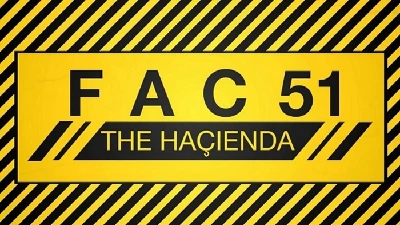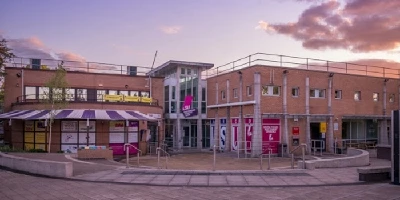Miscellaneous
-
2
published: 22 /
9 /
2021

In the second part of our series, in which our writers and photographers reminisce upon great venues, past and present, Nicky Crewe, John Clarkson and Cila Warncke remember The Hacienda in Manchester, the 1980's Loughborough University Students' Union and the 1990's London Camden Palace.
Article
THE HACIENDA, MANCHESTER
Fac 51, The Hacienda, opened its doors on May 21 1982, housed in a former yacht showroom, and designed by Ben Kelly for Factory Records. Now the club has its own mythology and legends, but on that first night they were unimaginable. I worked on the door and the cloakroom for the first few months. Most live music venues in Manchester at the time were workingmens' clubs and sticky carpeted dives, hired for the night. This was stylish, contemporary and even sophisticated, designed for purpose and image, with its distinctive hazard-tape colours, wide wooden floors and industrial metalwork. There was a bar in the cellar and a hairdressing salon in the basement.
In spite of the money lavished on design, the acoustics were never good for live music, but as things developed that didn’t matter. If you were in the box office on the door you were cut off from the music, but if you were on cloakroom duty you were able to see and hear. I loved the video screens too.
My experience of the club has little to do with its later incarnations but I’m still proud to say ‘I was there’.
NICKY CREWE
LOUGHBOROUGH UNIVERSITY STUDENTS' UNION, LOUGHBOROUGH
There was a really good Ents Committee at Loughborough University during the three years I was there between 1983 and 1986. I had only ever seen one band before I went to Loughborough, a ropy covers band at a school disco. Going to university, however, gave me an education in more than one sense, providing me with much of my early knowledge of music and a lifelong love of gig-going
Such was his combination of charm and withering stage patter that Tom Robinson got the entire audience singing ‘Glad to Be Gay’, even the pint-swilling rugby players who had started out the night by hurling abuse at him. Long before he became the self-caricature that he is now, John Lydon and Public Image Ltd were sinister and terrifying, as were many of their fans. It seemed that the entire auditorium of the Student Union might erupt into riot or violence at any moment, but it confirmed a hero worship of him for me that all these years on has never quite gone away. Tears for Fears’ Curt Smith had been stricken by a stomach bug and vanished for two songs mid-set. “I’m sorry,” he explained sheepishly upon his return, “but if you have got to go you have got to go.”
And that was just during the first term….
The Damned’s vampiric singer Dave Vanian bowed at the end of a number, as a full plastic pint pot shot over his head and splattered on top of a furious Rat Scabies and his drum kit. The late Lee Brilleaux, chain-smoking his way through the entire set and dressed in a filthy white suit that looked like he had hard-partied in it for a week, exuded extraordinary stage presence in a double bill with his band Dr Feelgood and Eddie and the Hot Rods. Marc Almond, towards the end of a lengthy set of almost entirely new material, turned on a member of the audience who shouted out for ‘Tainted Love’ one too many times. “Soft Cell have been over for two years,” he hissed. “Now shut the fuck up!”
I also saw the short-lived but influential Fiat Lux and Orchestral Manoeuvres in the Dark during my time there, both bands whom many years later I would interview, and the Bluebells with my brother when he was down for the weekend from Edinburgh, the first of only two gigs that I have seen with him to date.
The final band that I saw at Loughborough, the week before I left in June 1986, was New Order. They didn’t do encores in those days, but did that night, forced into it by the promoters who allegedly had refused to otherwise pay them, churlishly banging their way through it in ninety seconds. It is the last of several strong snapshot memories of those gigs that I have, and some of the best nights of my student life.
JOHN CLARKSON
CAMDEN PALACE, LONDON
We called it Camden Dirt – a tarry gunge enfossiling a thousand lost nights. It might have been an accretion of grime, cigarette ash, booze and bodily fluids bedded in the carpet; it might have been the carpet itself returning to a primal state.
Camden Dirt crawled under fingernails, oozed through furry boots and smudged Day-Glo tops. We wore it with pride.
The Camden Palace opened in 1900. Ninety-seven years later, on my first trip to London, I cajoled my older (wiser) sister into Feet First, the Tuesday indie disco that ran for nearly two decades. That night was my first drink at a bar, first kiss on a dancefloor.
When I moved to London in 2001 friends took me to Peach at Camden Palace, handed me two pills and said, tell us how you feel in half an hour.
The Palace had been an opera house, theatre, cinema, BBC Radio studio and live venue. Monty Python’s Flying Circus recorded there; Madonna, The Clash, Prince and Husker Du performed. Bon Scott drank there the night he died.
My friends and I didn’t know its history, nor did we care.
We cared about the pills and wraps of speed tucked into trainers. Cared about hurtling into the laser-etched blackness of the main room to catch a wave of bass against our chests. About puddling on the stairs, talking about nothing we would remember, oblivious to the surrounding elegance of worn brass and burnished wood.
Camden Palace didn’t survive for a over a century on good behaviour. It stood – stands now, as Koko – because people need pleasure, need to forget tomorrow and yesterday. It wasn’t sacred to us, it was our playground. The music and drugs didn’t last but the joy of that freedom has never faded.
CILA WARNCKE
Picture Gallery:-

